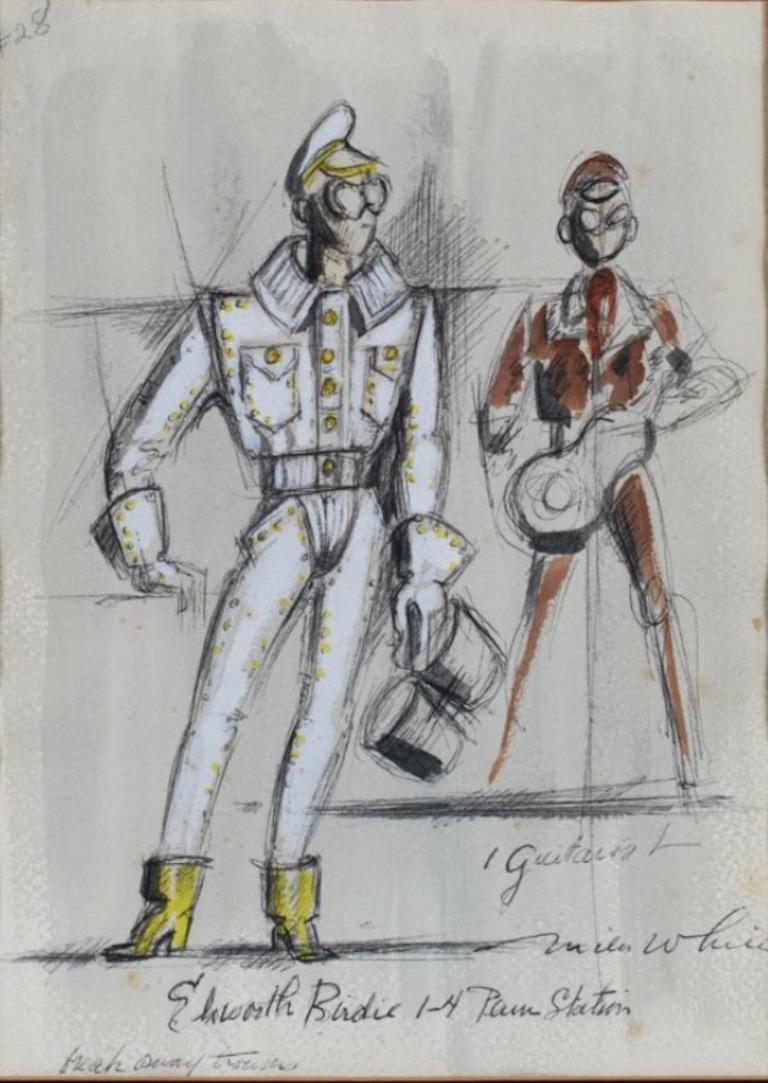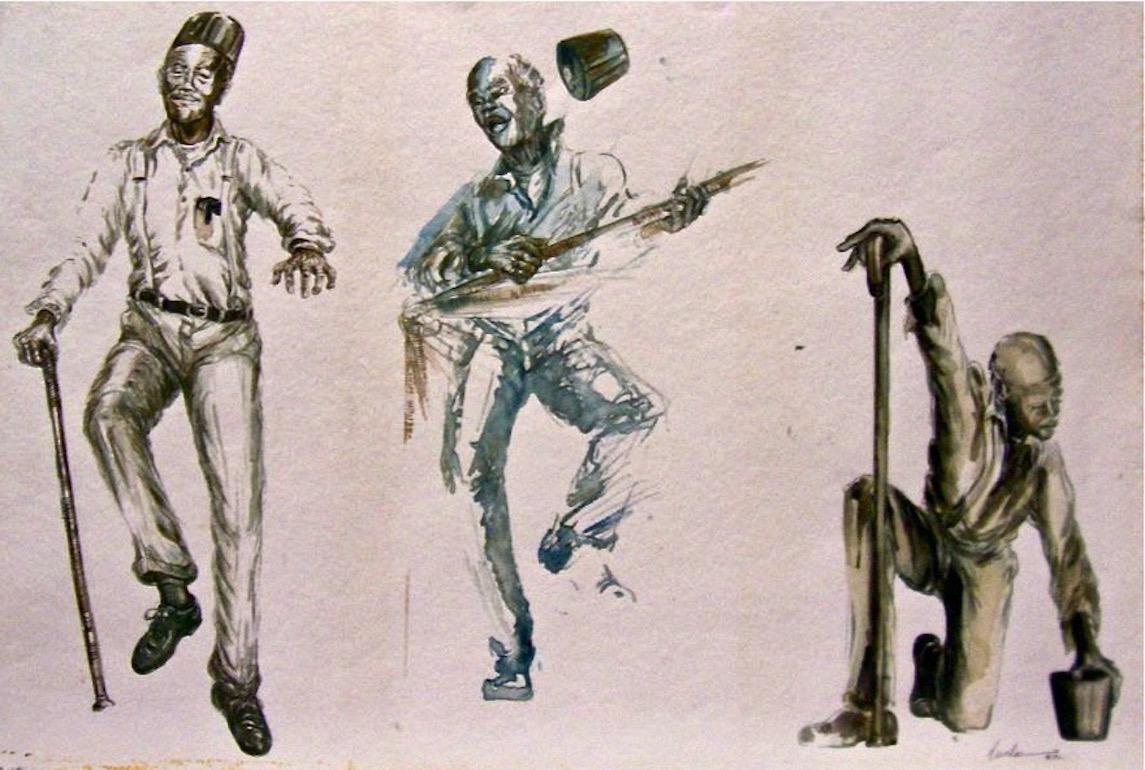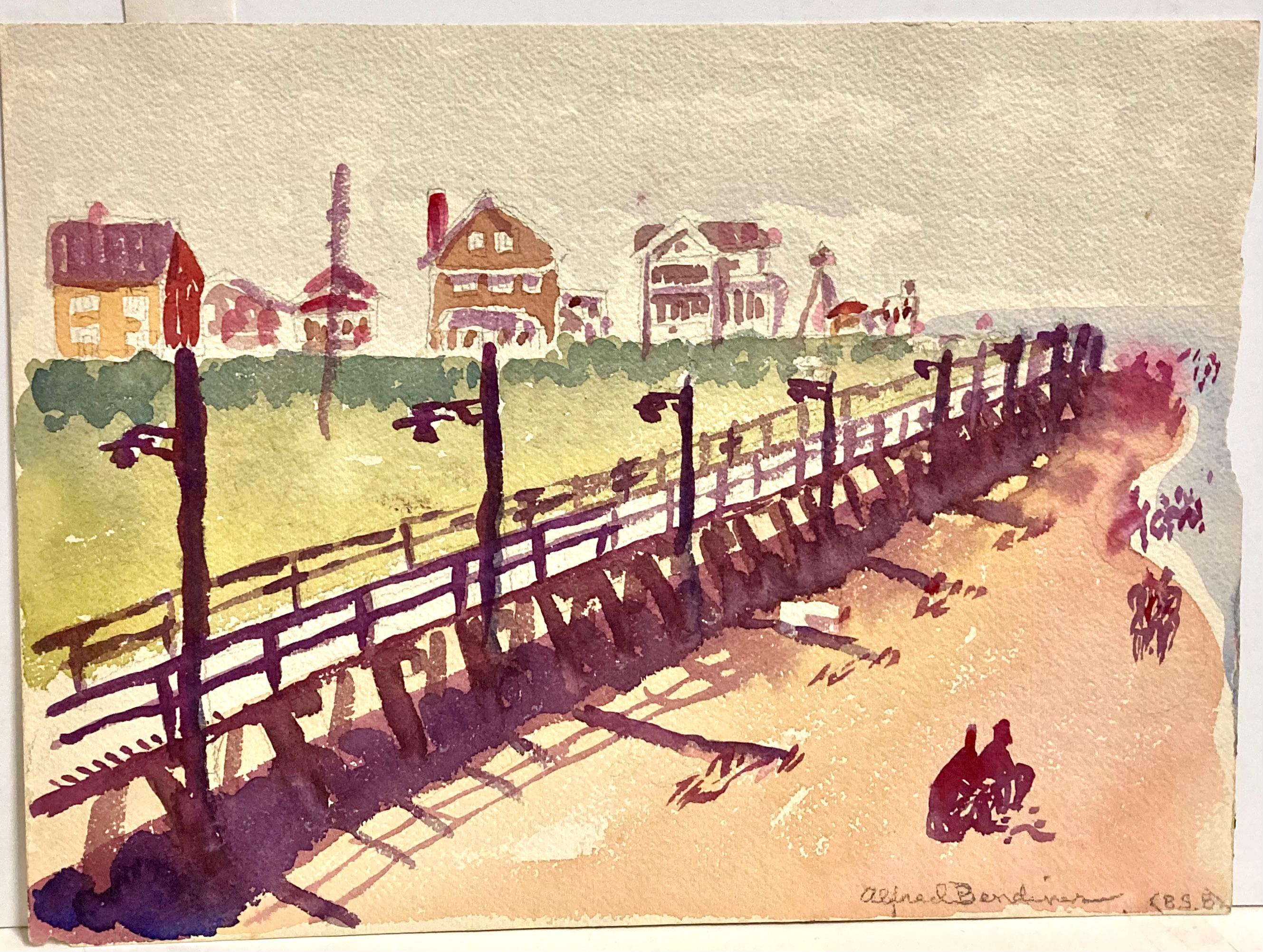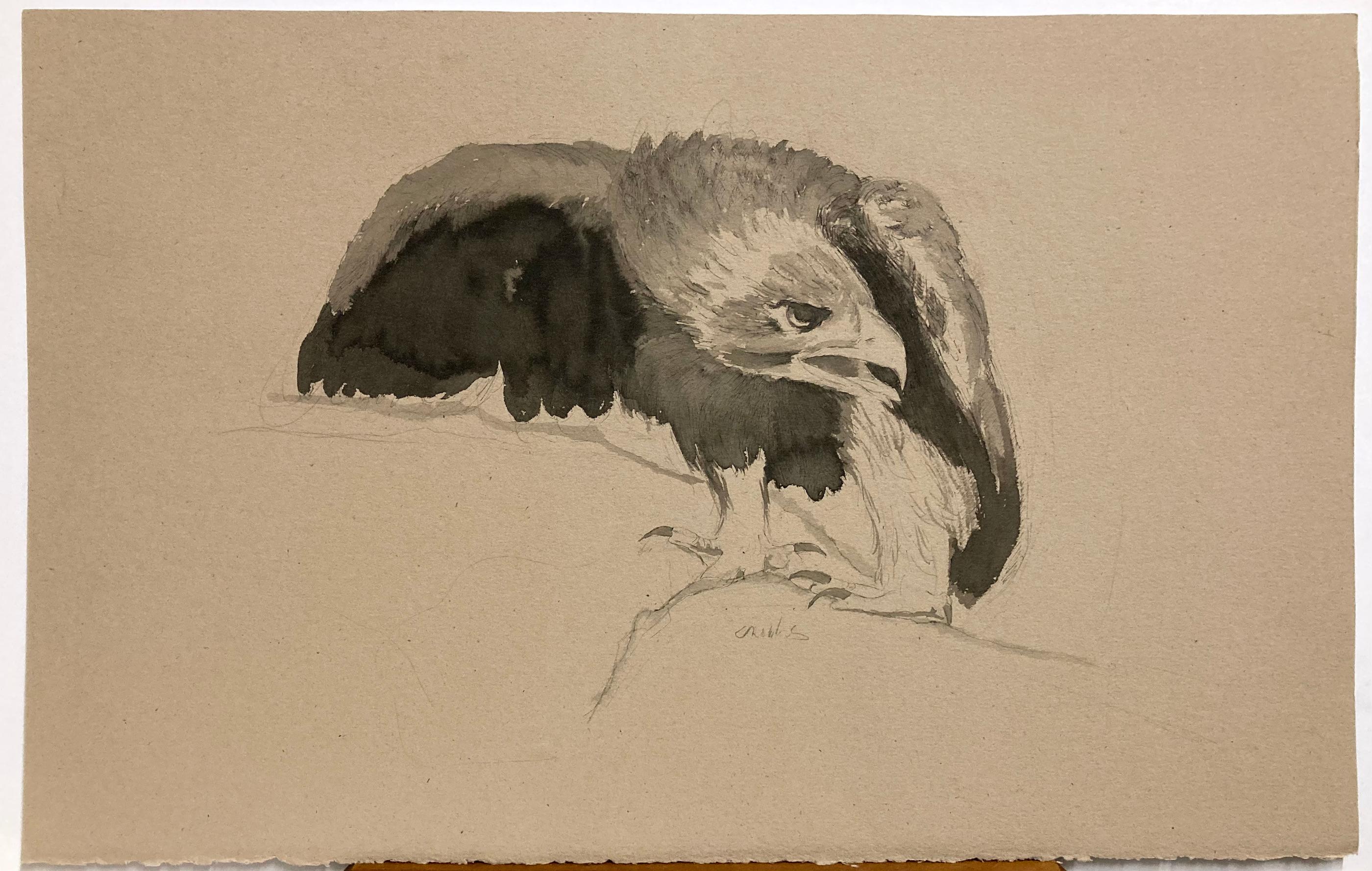Items Similar to Two Women and a Child on the Beach at Provincetown
Want more images or videos?
Request additional images or videos from the seller
1 of 10
Charles DemuthTwo Women and a Child on the Beach at Provincetownc. 1934
c. 1934
About the Item
Two Women and a Child on the Beach at Provincetown
Unsigned.
Watercolor on paper, c. 1934
A beautiful Provincetown beach scene, included in the catalogue raisonne.
Please see Babcock Gallery's scholarship (included in photos)
This watercolor show's the artist's mature precisionist technique and artful omission of detail.
Condition: excellent
Image size: 8 1/2 x 10 1/2 inches
Frame size: 16 x 18 inches
Housed in a 22K White Gold frame with conservation glass
Provenance:
James Maroney, Inc. (label)
Sid Deutsch Gallery (label)
Hirschl & Adler Galleries (label)
Babcock Galleries (label)
Zabriskie Gallery (label)
Exhibitions:
Little Rock, AR, Arkansas Art Center, December 3, 2004 - February 6, 2005: "2004 Collector's Show and Sale,"
"When he was asked to provide a brief autobiography, Demuth responded, “I was born November 8th 1883, studied at the Pennsylvania Academy of the Fine Arts under William M. Chase and Thomas Ancheus. I went to Paris in 1907 for the first time and afterwards returned to it in 1912 and 1921, living there and in London during these visits—about four years in all. I have exhibited at the Pennsylvania Academy and the Daniel Gallery in New York City. I think that is the limit of my knowledge about myself. I suppose you will reply, “Know thyself, young man.”
Demuth has an almost Forrest-Gump-like quality of being in the right place at the right time. He was in Paris before the war, in Gertrude Stein’s salon with Picasso and later with Hemingway. He was in New York as a member of Alfred Stieglitz’s circle as the early modernist movement is taking place and the Stieglitz group struggles with creating a market for modern art in America and, at the same time, defining an American style of art. He was close with Marcel Duchamp, Marsden Hartley, Georgia O’Keeffe, and Alfred Stieglitz. Georgia would visit him in Lancaster and the two would paint in his mother’s garden. " Demuth web site
"While he was in Paris he met Marsden Hartley by walking up to a table of American artists and asking if he could join them. He had a great sense of humor, rich in double entendres, and they asked him to be a regular member of their group. Through Hartley, he met Alfred Stieglitz and became a member of the Stieglitz group. In 1926, he had a one-man show at the Anderson Galleries and another at Intimate Gallery, the New York gallery run by Stieglitz. Demuth was introduced to modernism during trips to Europe between 1907 and 1921. On frequent trips to New York City, he encountered avant-garde styles and ideas, most notably Cubism, the influence of which is reflected in many of his works.
In Vaudeville (Dancer with Chorus), 1918, in the Philadelphia Museum of Art
His most famous painting, I Saw the Figure 5 in Gold, was inspired by his friend William Carlos Williams's poem "The Great Figure". Roberta Smith described the work in The New York Times: "Demuth's famous visionary accounting of Williams, I Saw the Figure Five in Gold, [is] a painting whose title and medallion-like arrangement of angled forms were both inspired by a verse the poet wrote after watching a fire engine streak past him on a rainy Manhattan street while waiting for Marsden Hartley, whose studio he was visiting, to answer his door.” Describing its importance, Judith H. Dobrzynski in The Wall Street Journal wrote: "It's the best work in a genre Demuth created, the 'poster portrait'. It's a witty homage to his close friend, the poet William Carlos Williams, and a transliteration into paint of his poem, 'The Great Figure'. It's a decidedly American work made at a time when U.S. artists were just moving beyond European influences. It's a reference to the intertwined relationships among the arts in the 1920s, a moment of cross-pollination that led to American Modernism. And it anticipates pop art."
Demuth's home in Lancaster, where he died, now the Demuth Museum
The work is one of 10 poster portraits Demuth intended to create to honor his creative friends. The six completed ones were in homage to Williams plus Georgia O'Keeffe, Arthur Dove, Charles Duncan, John Marin and Bert Savoy. The others were planned for Marsden Hartley, Gertrude Stein, Eugene O'Neill and Wallace Stevens. Painted during a period of recovery from illness, these paintings portray their respective painters and writers and performers through referential objects and language, as opposed to literal depictions. These works proved to be a challenge for critics. One reviewer described the works as having been made in “a code for which we have not the key.”
Demuth, along with Georgia O'Keeffe and Charles Sheeler, was a major contributor to the Precisionist art movement, which began to evolve in America around 1915. Demuth's works often depicted a specific range of forms in a quasi-Cubist, sharply defined manner, a characteristic of Precisionism. Frequently occurring scenes within Demuth's works are urban and rural landscapes, often consisting of industrial features such as bridges, smoke stacks, and skyscrapers. Demuth's "Aucassin and Nicolette," which can be viewed below, is an exemplary work of Precisionist art. Notable features include the highly structured scene lacking figures, depiction of an industrial setting, and sharp linearity created by geometric figures with no hint of abstraction. Demuth's works of this nature have been perceived as ironic and pessimistic in light of their subject matter.
Demuth began a series of paintings in 1919, inspired by the architecture of Lancaster. In creating these works, Demuth opted not to use watercolors, instead created the works in oil and tempera. Additionally, these works are larger than many of his others. They possess a balance between realism and abstraction. In 1927, Demuth started a series of seven panel paintings depicting factory buildings in his hometown. He finished the last of the seven, After All in 1933. Six of the paintings were highlighted in Chimneys and Towers: Charles Demuth’s Late Paintings of Lancaster, a 2007 Amon Carter Museum retrospective of his work, displayed in 2008 at the Whitney Museum of American Art. According to the exhibit notes from the Amon Carter show, Demuth's will left many of his paintings to Georgia O'Keeffe. Her strategic decisions regarding which museums received these works cemented his reputation as a major painter of the Precisionist school.
Later years and death
Demuth, a gay artist, was a regular patron at the Lafayette Baths. His sexual exploits there are the subject of watercolors, including his 1918 homoerotic self-portrait set in a Turkish bathhouse.
Demuth spent most of his life in frail health. By 1920, the effects of diabetes had begun to severely drain Demuth of artistic energy. He died at his residence in Lancaster County, Pennsylvania at the age 51 of complications from diabetes. He is buried at the Lancaster Cemetery." Courtesy of Wikipedia
- Creator:Charles Demuth (1883-1935, American)
- Creation Year:c. 1934
- Dimensions:Height: 8.5 in (21.59 cm)Width: 10.5 in (26.67 cm)
- Medium:
- Movement & Style:
- Period:
- Condition:Original.
- Gallery Location:Fairlawn, OH
- Reference Number:
About the Seller
5.0
Recognized Seller
These prestigious sellers are industry leaders and represent the highest echelon for item quality and design.
Platinum Seller
These expertly vetted sellers are 1stDibs' most experienced sellers and are rated highest by our customers.
Established in 1978
1stDibs seller since 2013
711 sales on 1stDibs
Typical response time: 1 hour
Associations
International Fine Print Dealers Association
- ShippingRetrieving quote...Ships From: Fairlawn , OH
- Return PolicyA return for this item may be initiated within 10 days of delivery.
More From This SellerView All
- Chain Gang MusicBy Stephen LongstreetLocated in Fairlawn, OHChain Gang Music Watercolor on paper, dated '39, but created in the 1970's Signed "Longstreet" lower left corner Titled and annotated "George - '39" in pencil at top of sheet Provenance: Acquired from the artist Joseph M. Erdelac, friend and patron of the artist Born Henri Weiner (sometimes spelled Wiener), the artist tried alternate names and personae including Paul Haggard, Thomas Burton, and David Ormsbee before settling on the name Stephen Longstreet in 1939. Longstreet dates his art based on the period he means to represent, not the actual date of execution. Stephen Longstreet (1907-2002) The artist’s own grandchildren attempt to fathom the real life and nature of Stephen Longstreet, prolific author, artist, screenplay writer, and jazz aficionado. Born Chauncy Weiner (sometimes spelled Wiener) in New York City in 1907, Longstreet reinvented himself on a regular basis. Changing his name first to “Henry,” then “Henri,” he started his career as a commercial artist for a department store. In various public biographies he claimed to have studied in New York, London, and Paris, and said he was a student of cartoonist Ralph Barton...Category
1970s American Modern Figurative Drawings and Watercolors
MaterialsWatercolor
- Girl in ProfileBy William SommerLocated in Fairlawn, OHGirl in Profile Lithographic crayon and watercolor on thin wove paper, c. 1930 Signed twice in pencil (see photos) Provenance: Estate of the Artist Edward Somme...Category
1930s American Modern Figurative Drawings and Watercolors
MaterialsWatercolor
- Head of a Young Woman with Blond HairBy William SommerLocated in Fairlawn, OHHead of a Young Woman with Blond Hair Watercolor on paper mounted on rag paper support, c. 1930 Signed with the Estate Stamp B Provenance: Estate of the Artist ...Category
1930s American Modern Figurative Drawings and Watercolors
MaterialsWatercolor
- Lonly (Lonely)By Stephen LongstreetLocated in Fairlawn, OHSigned lower right Provenance: Joseph M. Erdelac, Cleveland, OH Possibly deaccessed from the Columbus Museum of Art THOMAS FRENCH FINE ART, LLC Stephen Longstreet (1907-2002) A...Category
20th Century American Modern Figurative Drawings and Watercolors
MaterialsWatercolor
- Interior Scene with FiguresBy Louis SchankerLocated in Fairlawn, OHInterior Scene with Figures Ink and watercolor on paper, c. 1930's Signed with the Estate stamp lower center Condition: Loss upper right corner; two small tears lower margin Colors very fresh and vibrant Provenance: Jem Hom Gallery, Washington, D.C. Martin Dimanond Fine Arts, NYC (?) Louis Schanker (1903–1981)[1] was an American abstract artist. "He grew up in an Orthodox Jewish environment in the Bronx, New York. His parents, Sam, a tailor, and Fannie Schanker, were of Romanian descent.[2] He had five siblings.[3] At an early age he had an interest in both art and music He took art courses at Cooper Union, The Educational Alliance and The Art Students League with Barnett Newman, Mark Rothko and Milton Avery amongst others. During this time he shared a coldwater studio with the Soyer brothers, Chaim Gross and Adolph Gottlieb. In 1920 he traveled across the country. He lived the hobo life, joined the Sparks and then Barnum and Bailey circuses, later working as a thresher in the wheat fields of the Great Plains. There are elements in his works such as the circus murals...Category
1930s American Modern Drawings and Watercolor Paintings
MaterialsWatercolor
- Two Studies of Henriette (Head of the artist's wife & The Artist's wife writingBy Leon KellyLocated in Fairlawn, OHTwo Studies of Henriette (Left: Head of the artist's wife, Right: The Artist's wife writing a letter) Watercolor and graphite on paper, 1928-1930 Signed in pencil lower right (see photo) Image/sheet size: 9 3/8 x 11 inches Condition: Excellent Colors fresh and unfaded Provenance: Estate of the artist The Orange Chicken...Category
1920s American Modern Figurative Drawings and Watercolors
MaterialsWatercolor
You May Also Like
- Original Painting. Colliers Cover Published. American Scene Christmas ModernBy Antonio PetruccelliLocated in New York, NYOriginal Painting. Colliers Cover Published American Scene Christmas Modern Antonio Petruccelli (1907 - 1994) Man with Ribbon Colliers published,...Category
1930s American Modern Figurative Paintings
MaterialsGouache, Board
- BYE BYE BIRDIE Original 1960 Broadway Musical Costume Drawing Tony Award ElvisLocated in New York, NYBYE BYE BIRDIE Original 1960 Broadway Musical Costume Drawing Tony Award Elvis. Miles White (1915 – 2000) BYE BYE BIRDIE 11 x 8 inches Mixed Media on...Category
1960s American Modern Figurative Drawings and Watercolors
MaterialsWatercolor, Gouache, Pencil
- Curlee Raven Holton, Three Views of a DancerLocated in New York, NYA painter, draftsman, printmaker and master printer, Curlee Raven Holton (born 1951) taught for twenty years at Lafayette College, Pennsylvania, a...Category
1980s American Modern Figurative Drawings and Watercolors
MaterialsWatercolor
- Alfred Bendiner, Avalon (New Jersey)By Alfred BendinerLocated in New York, NYApparently Bendiner never went a day without drawing. He was amazing! From Bendiner's Philadelphia the New Jersey beaches were an easy drive. Avalon is st...Category
Mid-20th Century American Modern Figurative Drawings and Watercolors
MaterialsWatercolor
- Blanche Grambs, EagleLocated in New York, NYBlanche Grambs, whose career started with the WPA, was an extremely skilled draftsperson. Her birds are masterful. Here an eagle, a majestic bird-of-pr...Category
1970s American Modern Figurative Drawings and Watercolors
MaterialsWatercolor
- Alfred Bendiner, Santa Fe Cowhands (New Mexico)By Alfred BendinerLocated in New York, NYApparently Bendiner never went a day without drawing. He was amazing! In this scene of a young 'cowgirl' is working a lasso while an 'old cowhand' looks on -- clutching a cigaret of...Category
1950s American Modern Figurative Drawings and Watercolors
MaterialsWatercolor
Recently Viewed
View AllMore Ways To Browse
Art Work Paintings John Marin
J Sullivan
Rick Evans
John Lennon Happy Life
Ruth Wilcox
Colefax And Fowler Curtains
Jack Ramsey
Archie Motley
Divan De Milieu
Parker Daniels
Pend Oreille
Watercolor 1960s Signed
Watercolor Lincoln Painting
Vivid Watercolor
Chinese Watercolor Paintings Bird
Orlando Pelayo
Bernard Kohn
William Mangum




